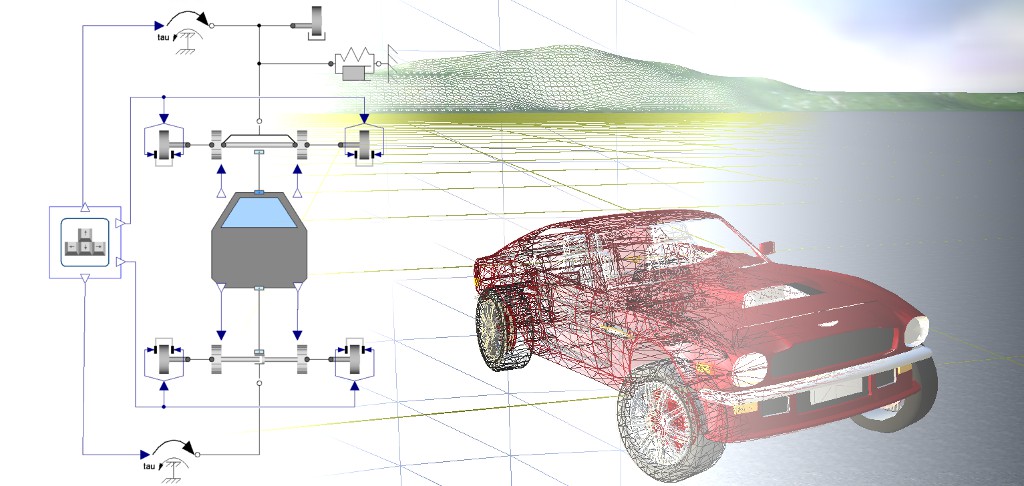Dirk Zimmer ‒ VirtualPhysics_de

Virtual Physics
Dr. Dirk Zimmer
TUM Computer Science: Robotics and Embedded Systems
WS 2020/2021: Tuesday, 14-17 (2V+1U). Seminarroom 00.08.059 (TUT.) FMI Garching
Contact: Diese E-Mail-Adresse ist vor Spambots geschützt! Zur Anzeige muss JavaScript eingeschaltet sein!
Lecture Content
This video shows the car simulation that all students can model during this curse
(in case the video does not play in the browser, you may download it to play)
Computer games, driving simulators, control of robots, or optimization of aircraft design: all these applications require suitable and efficient models of their physical processes. This lecture offers an introduction to object-oriented, declarative languages such as Modelica and demonstrates their application for the purpose of computer simulation.
Starting from physical principles, the lecture explains how to model electrical and mechanical systems. The development of extensive modeling-libraries is outlined and illustrated by suitable mechatronic systems. The modeling of further physical domains is briefly sketched.
In addition, the lecture concerns the computational aspects of computer simulation. The processing of the modeling language is explained in detail and the most important algorithms for time-integration are presented.
The corresponding exercise sessions offer the opportunity for the participants to gain their own modelling experience, for instance by creating a mechanic modelling library. Finally, the participants are encouraged to develop a real-time simulation of a vehicle. A high interest in physics but no additional prerequisites are expected for this lecture. All important fundamentals will be explained in the lecture.
The lecture will contain a rich set of exercises at beginners level that shall ease the learning of the modeling language Modelica. Furthermore one or two lecture dates will be seized for hands-on practical exercises to provide further assistance. In addition, the lecture provides a more thourough repetition of fundamental physics, especially suited for CS students.
Slides
The lectures slides will be available to print out before the actual lectures takes place.
-
Lecture 1: (17.10.2022) Introduction and Outline: Motivation and Purpose of Modelling and Simulation
1A (slides)
1B (slides)
Additional Material: yeast.py and yeast.mo in supplement 1
Additional Material: PanicBuying.py in supplement 2
License Agreement -
Lecture 2: (08.11.2022) History of object-orientation modeling of physical systems
2A (slides)
2B (slides) -
Lecture 3: (08.11.2022 / 15.11.2022) The Modelica language
3A (slides)
3B (slides) -
Lecture 4: (15.11.2022) Compiling the Modelica language
4 (slides) -
Lecture 5: (22.11.2022) Introduction to 1D and 2D mechanical systems
5A (slides)
5B (slides)
Supplementary Material - Exercise Session (29.11.2022)
-
Lecture 6: (06.12.2022) Planar mechanical systems I+II.
6A (slides)
6B (slides)
Supplementary Material -
Lecture 7: (13.12.2022) 3D Mechanics and continuation of Lecture 6
7A (slides)
7B (slides)
Supplementary Material ; -
Lecture 8: (20.12.2022) Modeling the Car and Real-Time Simulation
8A (slides)
8B (slides)
Supplementary Material -
Lecture 9: (20.12.2022 / 10.01.2023) Higher-Level Modeling Tasks: Parameterization and Stability Analysis
9A (slides)
9B (slides) -
Lecture 10: (10.01.2023) Analyitical vs. Numerical Stability and Higher-Order ODE Solvers
10A (slides)
10B (slides) -
Lecture 11: (17.01.2022) Events and discontinuous systems
11 (slides)
Supplementary Material -
Lecture 12: (24.01.2023) Control + Exam Preparation I
12 (slides) - Lecture 13: (31.01.2023) Bonus Lecture on SpaceX Example + Exam Preparation II
Exercises and Solutions
There will be 12 exercises. Many of them involve practical modeling work.
- Exercise 1: Sheet
- Exercise 2: Sheet, Solution
- Exercise 3: Sheet , SimpleSpringDamperTask.zip, Solution
- Exercise 4: Sheet , Solution: SimpleHydraulics.zip
- Exercise 5: Sheet , Solution
- Exercise 6: Sheet, Solution
- Exercise 7: Sheet , Solution
- Exercise 8: Sheet, Solution is contained in the supplementary material of the lecture
- Exercise 9: Sheet , Solution is contained in the supplementary material of the lecture
- Exercise 10: Sheet , Solution
- Exercise 11: Sheet, Solution
- Exercise 12: Sheet, Solution
Exam
There will be an exam of 90min duration.
The following rules apply:
- Each student is allowed one sheet (having 2 pages) of A4 paper with her or his own handwritten notes. No further notes or books are allowed.
- No electronic devices are allowed.
- The exam is written on the provided exam-sheets. Further sheets can be retrieved upon request.
- Beverages and snacks with low-noise level are ok
Additional Software
- Planar Mechanics for Open Modelica (contains 3d car and SN6 Example)
- SimVis Community Edition (you can request a free download)
- SimVisStudentVersion (contains 3D files for car)
- DeviceDriver (should also be part of OM or Dymola)
